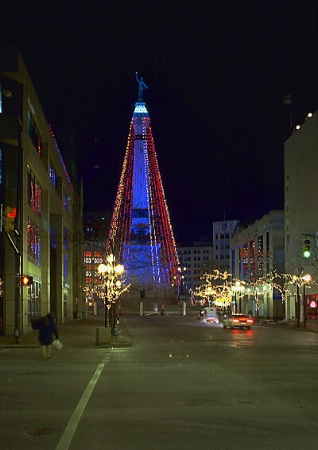John A. Lind |
|
|
|
|
|

Monumental Christmas
Ektachrome 160T [tungsten balanced], f/16, shutter speed not recorded (long!), 35mm f/2.8 Shift, Indianapolis, IN
John A. Lind
|
|
|
|
Brad,
There are likely two effects going on here. The first is man-made lighting is not daylight. It's a different "color" compared to daylight. Your brain . . . very closely connected to your eyes . . . does a magnificent job of "color balancing" but if you work at it for a while, you can begin to "see" at least some of the difference. It isn't easy; you're fighting your own brain and how it's organized itself for processing visual information at a low level to do this.The other part of it, depending on how long the exposures are, can be "reciprocity failure." As shutter speeds are lengthened, eventually it reaches a point the film does not respond as quickly . . . the effective film speed decreases . . . but it doesn't necessarily do so for all layers in the film emulsion at the same rate . . . also resulting in a color shift. The length of exposure at which reciprocity failure effects occur varies for each film; it can start as short as one second or as long as 30 seconds. Details about it and how to correct for it are found in the data sheet for each film. Look under the "exposure" section of the data sheet. See Kodak's web site for their data sheets, and Fujifilm's site for theirs. They both have them on-line in their support areas. IIRC, Provia can sustain very long exposures, over two minutes, before hitting reciprocity failure . . . and even then it's not much in exposure or color shift. Your experience with Provia is very, very likely daylight film with man-made lighting, not reciprocity failure. Also, IIRC, Velvia 50 is not nearly as friendly to very long exposures . . . limit is about 1 second with reciprocity failure fairly mild out to about 6-8 seconds (requiring very little correction). Likewise, unless you're making very long exposures with Velvia, the bulk of the effect is still very likely the daylight film with man-made lighting mismatch. With night cityscapes, even if you rigorously correct for reciprocity failure (which I generally don't worry about too much) there is still have the color imbalance from using daylight film with man-made lighting, and that has a much greater effect. You might try using some Kodak Ektachrome 160T, a tungsten balanced film for night city scenes with floodlights. It will still not be perfectly balanced (man-made floods and street lights are not photofloods either), but you may prefer its color rendition compared to what you're getting now. I've used it on several occasions in night cityscapes for the "color shift" reasons you mention and it's worked out closer than using daylight films. I've uploaded a photo shot using Ektachrome 160T so you can get some idea what it's like. Some of the floods have a fairly high blue content compared to most man-made lights . . . deliberately designed that way . . . to make what they're spotlighting on the monument appear "brighter" to the eye at night. The christmas lights on the monument were red, white and blue (and typical low wattage incandescent [tungsten]). The blue ones are comparatively very dim; tungsten filament bulbs give off very little blue content in their light. -- John Lind
July 11, 2004
|